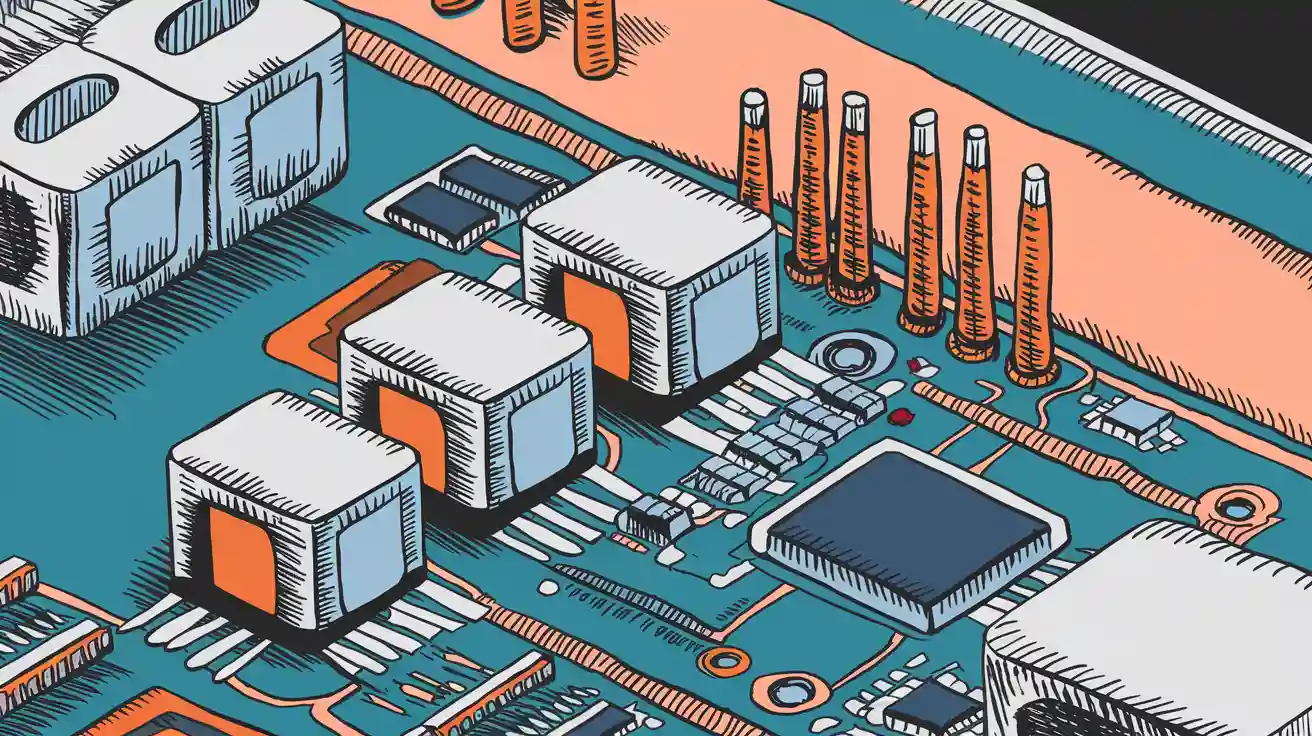Exploring the Best PCB Stiffeners for Modern Applications
Flexible PCBs are known for their adaptability, but they often require additional support to maintain structural integrity. This is where the role of stiffener in flex PCB design becomes critical. A PCB stiffener provides localized reinforcement, ensuring that delicate areas withstand mechanical stress during assembly or operation.
You’ll find these stiffeners indispensable in applications involving connectors, components, or solder joints. They not only enhance durability but also improve reliability, especially in rigid-flex PCB designs where flexibility and rigidity must coexist seamlessly.
Key Takeaways
- PCB stiffeners help keep flexible circuit boards straight and strong.
- Picking the right stiffener material, like FR4 for heat or polyimide for bending, is very important.
- Look at your design’s needs and where it will be used to choose the best stiffener.
- Aluminum stiffeners are cheap and work well for lightweight gadgets.
- Test your PCB design in real-life situations to make sure the stiffener works properly.
What Are PCB Stiffeners?
Definition and Purpose
A PCB stiffener is a structural component that reinforces specific areas of a flexible circuit board. You use it to provide mechanical support, ensuring the board maintains its shape and functionality during assembly or operation. Stiffeners are essential in flex PCB designs, especially when connectors, solder joints, or components require additional stability.
These stiffeners prevent bending or warping in critical zones, which can compromise the circuit’s performance. By adding rigidity to targeted sections, they enhance the durability of flexible PCBs and rigid-flex designs. You’ll find them particularly useful in applications where mechanical stress or repeated flexing is common.
Tip: When designing flexible PCBs, always evaluate the need for stiffeners early in the process. This ensures optimal placement and avoids costly redesigns later.
Common Materials
PCB stiffeners come in various materials, each suited to specific requirements. You’ll often encounter the following options:
- FR4: This fiberglass-reinforced epoxy laminate is widely used due to its excellent mechanical strength and thermal stability. It’s ideal for applications requiring rigidity and heat resistance.
- Polyimide: Lightweight and flexible, polyimide stiffeners are perfect for designs that demand high flexibility without sacrificing durability.
- Stainless Steel: Known for its strength and corrosion resistance, stainless steel stiffeners are used in high-strength applications.
- Aluminum: This material offers a balance between strength and weight, making it suitable for cost-sensitive designs.
Each material has unique properties that cater to different environmental conditions and mechanical requirements. You should select the one that aligns with your design goals and operational needs.
Types of PCB Stiffeners
FR4 Stiffeners
FR4 stiffeners are among the most commonly used options in PCB design. Made from fiberglass-reinforced epoxy laminate, they provide excellent mechanical strength and thermal stability. You’ll find these stiffeners particularly useful in applications where heat resistance and rigidity are critical.
One of the key advantages of FR4 stiffeners is their ability to maintain structural integrity under high temperatures. This makes them ideal for soldering processes or environments with significant thermal fluctuations. Additionally, their rigidity ensures that connectors and components remain securely in place, enhancing the overall performance of your flex PCB.
When incorporating FR4 stiffeners into your design, consider their thickness. Thicker stiffeners offer more support but may increase the overall weight and cost of the board. Striking the right balance ensures optimal functionality without compromising flexibility.
Note: FR4 stiffeners are best suited for rigid-flex PCB designs where durability and heat resistance are top priorities.
Polyimide Stiffeners
Polyimide stiffeners are a lightweight and flexible alternative to FR4. They are made from a high-performance polymer that offers excellent thermal and mechanical properties. If your design requires high flexibility without sacrificing durability, polyimide stiffeners are an excellent choice.
These stiffeners excel in applications where repeated bending or flexing occurs. For example, they are often used in wearable devices, foldable electronics, and other compact designs. Their lightweight nature also makes them suitable for weight-sensitive projects.
Polyimide stiffeners are easy to integrate into your design due to their compatibility with flexible circuit materials. They also perform well in extreme environmental conditions, such as high temperatures or exposure to chemicals. This versatility makes them a popular choice for modern applications.
Tip: Use polyimide stiffeners in areas that require frequent movement to maximize the lifespan of your flexible PCB.
Stainless Steel Stiffeners
Stainless steel stiffeners are the go-to option for high-strength applications. Known for their exceptional durability and corrosion resistance, they provide unmatched mechanical support. You’ll often see these stiffeners in designs that demand robust performance under heavy mechanical stress.
Their strength makes them ideal for industrial and automotive applications, where PCBs are exposed to harsh conditions. Stainless steel stiffeners also offer excellent dimensional stability, ensuring that your board maintains its shape even under extreme pressure.
However, their rigidity and weight can limit their use in designs that prioritize flexibility. If your project involves minimal bending and requires maximum strength, stainless steel stiffeners are a reliable choice.
Callout: Stainless steel stiffeners are perfect for applications where durability and mechanical stability are non-negotiable.
Aluminum Stiffeners
Aluminum stiffeners offer a unique balance of strength, weight, and cost-effectiveness, making them a versatile choice for many PCB applications. If your design prioritizes affordability without compromising structural support, aluminum stiffeners are worth considering. These stiffeners are particularly effective in scenarios where moderate rigidity is required, but excessive weight could hinder the overall performance of the device.
One of the key advantages of aluminum stiffeners is their lightweight nature. This property makes them ideal for portable electronics, where minimizing weight is crucial. Despite being lightweight, aluminum provides sufficient mechanical support to maintain the integrity of your flex PCB. It ensures that critical areas, such as connectors or solder joints, remain stable during operation or assembly.
Aluminum also offers excellent thermal conductivity. This feature helps dissipate heat efficiently, which is especially beneficial in designs that involve high-power components. By managing heat effectively, aluminum stiffeners contribute to the long-term reliability of your flexible circuit boards.
However, aluminum stiffeners may not be the best choice for applications requiring extreme flexibility. Their rigidity, while moderate, can limit the bending capabilities of your PCB. You should carefully evaluate the mechanical requirements of your design before selecting aluminum as your stiffener material.
Tip: Use aluminum stiffeners in cost-sensitive designs where weight reduction and thermal management are priorities.
When integrating aluminum stiffeners into your rigid-flex PCB, consider their thickness and placement. Thicker stiffeners provide more support but may increase the overall weight slightly. Strategic placement ensures that the stiffeners reinforce only the necessary areas, preserving the flexibility of the rest of the board.
Applications of Flexible PCB and Stiffeners
High-Flexibility Applications
Flexible circuit boards excel in designs requiring adaptability and movement. You’ll find flex PCBs with stiffeners particularly useful in wearable devices, foldable electronics, and medical equipment. These applications demand repeated bending or flexing without compromising performance.
Polyimide stiffeners are ideal for these scenarios. Their lightweight and flexible nature ensures the board maintains its integrity during continuous motion. For example, in wearable devices, stiffeners reinforce areas around connectors or solder joints, preventing damage from repeated use.
Tip: When designing for high-flexibility applications, prioritize stiffeners that complement the board’s movement without adding unnecessary rigidity.
High-Strength Applications
Certain designs require maximum durability to withstand mechanical stress or harsh environments. Rigid-flex PCBs with stainless steel stiffeners are perfect for these applications. You’ll often see them in automotive systems, industrial machinery, and aerospace components.
Stainless steel stiffeners provide unmatched mechanical support. They ensure the board remains stable under heavy loads or extreme conditions. For instance, in automotive systems, stiffeners protect critical areas from vibration and impact, enhancing the board’s reliability.
Callout: High-strength applications demand stiffeners that offer superior durability and corrosion resistance. Stainless steel is your best choice for these scenarios.
Cost-Sensitive Applications
Cost-sensitive designs require a balance between affordability and performance. Aluminum stiffeners are a popular choice for these applications. They provide moderate rigidity while keeping costs low, making them suitable for consumer electronics and portable devices.
Aluminum stiffeners also contribute to thermal management. Their excellent heat dissipation properties improve the board’s reliability in designs involving high-power components. For example, in budget-friendly smartphones, aluminum stiffeners reinforce connectors while managing heat effectively.
Note: Cost-sensitive applications benefit from stiffeners that offer structural support without inflating production costs. Aluminum delivers this balance effectively.
Key Factors for Choosing PCB Stiffeners
Application Type
The type of application plays a critical role in determining the ideal stiffener for your flex PCB. You must evaluate the mechanical and operational demands of your design. For instance, high-flexibility applications like wearable devices or foldable electronics benefit from polyimide stiffeners. These provide lightweight support while maintaining the flexibility of the board. On the other hand, rigid-flex PCBs used in industrial or automotive systems often require stainless steel stiffeners for maximum durability under mechanical stress.
When selecting a stiffener, consider the movement, stress, and environmental exposure your flexible circuit boards will face. Matching the stiffener material to the application ensures optimal performance and longevity.
Budget Considerations
Your budget significantly influences the choice of stiffeners. Cost-sensitive designs often prioritize affordability without sacrificing essential functionality. Aluminum stiffeners are a popular choice for such scenarios. They offer a balance of strength and cost-effectiveness, making them suitable for consumer electronics and portable devices.
However, if your design involves high-performance requirements, investing in premium materials like stainless steel or FR4 may be necessary. While these options are more expensive, they provide superior mechanical support and thermal stability. Carefully weigh the cost against the benefits to make an informed decision.
Environmental Conditions
Environmental factors such as temperature, humidity, and chemical exposure directly impact the performance of your flex PCB. You should select stiffeners that can withstand the specific conditions of your application. For example, FR4 stiffeners excel in high-temperature environments due to their thermal stability. Polyimide stiffeners perform well in chemically harsh or high-humidity conditions, ensuring the reliability of your flexible circuit boards.
If your design operates in extreme environments, prioritize materials with proven resistance to corrosion, heat, or moisture. This ensures the long-term durability of your flex circuit with stiffener and prevents premature failures.
Mechanical Requirements
When selecting a stiffener for your flex PCB, you must consider the mechanical requirements of your application. These requirements dictate how much support and rigidity the stiffener should provide to ensure optimal performance. Start by evaluating the stress points on your flexible circuit boards. Areas near connectors, solder joints, or components often experience the most strain and require additional reinforcement.
The level of flexibility needed in your design also plays a crucial role. For applications requiring frequent bending, such as wearable devices or foldable electronics, you should prioritize materials like polyimide. These stiffeners maintain the board’s flexibility while providing localized support. Conversely, if your rigid-flex PCB operates in high-stress environments, stainless steel or FR4 stiffeners offer the durability and rigidity needed to withstand mechanical loads.
You should also assess the thickness of the stiffener. Thicker stiffeners provide greater support but may reduce the overall flexibility of the board. Striking the right balance between rigidity and flexibility ensures that your design meets both mechanical and operational demands.
Tip: Always test your flex PCB under real-world conditions to verify that the stiffener meets the mechanical requirements of your application.
Evaluation Checklist
To streamline the selection process, use an evaluation checklist to ensure you choose the right stiffener for your flex PCB. Below is a simple checklist to guide you:
- Application Type: Does the stiffener align with the mechanical and operational needs of your design?
- Material Selection: Have you chosen a material that balances flexibility, durability, and cost?
- Environmental Suitability: Can the stiffener withstand the temperature, humidity, or chemical exposure of your application?
- Mechanical Support: Does the stiffener provide adequate reinforcement for stress points without compromising flexibility?
- Thickness and Weight: Is the stiffener’s thickness appropriate for your design without adding unnecessary weight?
- Thermal Management: Does the stiffener contribute to heat dissipation if required?
By addressing these questions, you can ensure that your flexible circuit boards perform reliably in their intended applications.
Callout: A thorough evaluation during the design phase can save you from costly revisions later.
Choosing the right PCB stiffener is essential for ensuring the performance and durability of your design. From FR4 and polyimide to stainless steel and aluminum, each material serves specific applications, whether you need flexibility, strength, or cost-efficiency. For instance, polyimide stiffeners excel in wearable devices, while stainless steel is ideal for industrial systems.
You should carefully evaluate your design’s mechanical needs, environmental conditions, and budget constraints. Selecting the right stiffener ensures your flexible circuit boards and rigid-flex PCB designs perform reliably. When in doubt, consult industry experts to optimize your design for long-term success.
Tip: A well-chosen stiffener can significantly enhance the lifespan and functionality of your PCB.
FAQ
What is the primary purpose of a PCB stiffener?
A PCB stiffener reinforces specific areas of a flexible circuit board. It provides mechanical support, prevents bending or warping, and ensures the board maintains its shape during assembly or operation. This improves durability and reliability in demanding applications.
How do you choose the right stiffener material?
You should evaluate your design’s mechanical needs, environmental conditions, and budget. For flexibility, choose polyimide. For strength, opt for stainless steel. FR4 works well in high-temperature environments, while aluminum balances cost and weight.
Can stiffeners affect the flexibility of a PCB?
Yes, stiffeners add rigidity to targeted areas, which can reduce flexibility. You should strategically place stiffeners to reinforce stress points while preserving the board’s overall adaptability.
Are PCB stiffeners necessary for all flexible circuit boards?
No, not all designs require stiffeners. You should assess your application’s mechanical stress, environmental exposure, and operational demands. Stiffeners are essential for areas prone to strain, such as connectors or solder joints.
How do stiffeners contribute to thermal management?
Certain stiffeners, like aluminum, offer excellent thermal conductivity. They help dissipate heat from high-power components, improving the board’s reliability and preventing overheating during operation.




















